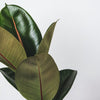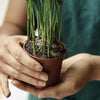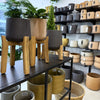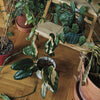A garden in glass
Creating a beautiful green oasis of calm at home from plants is perhaps the dream of every houseplant lover. But if the usual growing of plants is not enough for you, you can try to make your own mini-garden in a glass. Such a small ecosystem lives a life of its own, and if you choose suitable plants for it, it is very easy to care for. A magical garden in glass is a great aesthetic addition to a modern interior, but it was already very popular in Victorian England, where it could be seen in almost all luxury salons. A home mini-garden will definitely serve well as an interesting gift that you can make for someone yourself.

Plant terrariums (sometimes called florarias) look great not only standing alone, but also in a group where you can play around with different sizes or styles of containers. You can get a glass directly intended for planting, for example from glass sheets connected with a metal rim, but an ordinary kitchen jug, vase, old apothecary bottle or round aquariums will work just as well. (Caution! These should not house fish! So, with a clear conscience, move them out of them into a more suitable aquarium and fill the round ones with plants.) If you choose a container with a narrower cap, you may need to use long tweezers, chopsticks, or with other suitable tools, it may also require more skill, but the final effect will make up for all the difficulties! You can really win with the final decoration of such a garden. Shells, snail shells, twigs, pine cones can be used for decoration, there are no limits to imagination. You can even make the garden for or with the kids, creating a jungle for their little plastic animals. Little girls will certainly appreciate a fairy garden with a small doll or a fairy house.

If you have just decided to try to make such a home mini garden according to our instructions, think about these questions:
- Open terrarium, aerarium or closed terrarium?
- Terrarium placed in the sun or semi-shade?
The selection of suitable plants naturally depends on these criteria. For clarity, we will now focus on each type of terrarium separately. In general, however, it is better to choose plants that you will not have to transplant often due to their lush growth or those that would then disproportionately fill the entire space due to their size. If that's not your goal! It doesn't look bad at all if you choose one plant that will be dominant in the arrangement and will hang or extend out.

Open dry-loving terrarium and aerarium
Drought-loving plants that require less watering and better air flow will thrive in this type of terrarium. For such a home desert garden, an ordinary terracotta/clay saucer that is glazed from the inside (so that moisture does not seep in) will be enough. In this particular case, there is no need to put a drainage layer on the bottom (because the trays tend to be quite low/not very deep), just don't forget about it when watering and if you choose the recommended cacti and succulents, really only water sporadically and place the finished mini-garden in a sufficiently lit place, take it easy even in direct sunlight.
We will now demonstrate the production of such a terrarium in the following points:
1) If you choose a larger terrarium, be sure to put a drainage layer of pebbles or expanded clay on the bottom so that the roots of dry-loving plants do not stand in water. Then cover this layer with sand to fill the gaps between the pebbles.

2) Then add a layer of substrate in which the plants will be planted. Think about whether you want to see the substrate from the viewing side or not. In the first case, it is a little easier and you can directly add a layer of substrate over the entire surface of your container. We will explain below how to make the substrate invisible.

3) The next step is cleaning the root ball of the selected plant and planting it.


4) Finally, sprinkle the surface with small pebbles, you can add a few pebbles, seashells, whatever you like.

If you like the 'desert' type of mini-garden more and you have chosen a glass container in which all parts can be seen, make sure that the substrate does not shine through between the pebbles. So leave it only in the middle part of the container. You can achieve this by pouring a layer of gravel on the bottom of your chosen container, which you cover with sand to fill the gaps between the pebbles. Then layer a little substrate in the middle in a smaller mound, which you will cover with pebbles on the sides of the container and fill the holes between them again with sand. Then just add the substrate and plant the plants. Finally, beautify the surface of the pebble arrangement again with more gravel, etc.
Suitable plants for a dry terrarium:
- all kinds of succulents and cacti
- small species of the genus Crassula
- species of the genus Haworthia
- Echiveria _
- species of the genus Peperomia (peppermint)
- small species of the genus Sanseveria (mother-in-law's tongue, tenura)
- air plants Tillandsia - you don't even need to plant them, because they live only from air humidity. All you have to do is hang them somewhere, place them on a plinth, in a bowl or treat them to their own hanging aerarium, in which they look absolutely perfect - see for yourself!

Closed or humid terrarium
Closed terrariums can create their own water cycle, which means that they practically do not need our care, but take care of themselves. However, it is advisable to give them air exchange and water replenishment once in a while, for example once every 2-3 weeks we open the lid, let it air out for at least 20 minutes, then we can water the plants a little or spray them with a sprayer and close them again. For this reason, plants that benefit from higher air humidity and still slightly moist soil will thrive here. When you choose an open terrarium, you only have to think about watering the plants and the substrate more often.

How to make such a hygrophilous terrarium?
1) We start again with a drainage layer made of pebbles or expanded clay. Just because plants like moisture doesn't mean their roots will sit in water! This is precisely what we avoid with this first drainage layer.
2) We can also add a little charcoal to this layer (or on top of it), which will soak up any residual water that would otherwise sit at the bottom of the container, thus reducing possible mold growth.
3) The substrate will come on top of this layer, plants will be added to it, and finally we can arrange moss, cones, bark, various sticks, etc. on the surface.

It is better to work with a dry substrate when planting plants, the walls of the container do not stick, and when you clean the plants with a sprayer at the end, you will not needlessly over-wet the substrate. Also clean the walls of the container from all soil, dust or moss residues so that enough light can penetrate through the glass to the plants.
Place the hygrophilous terrarium where there is no direct sunlight, depending on the selected plant species, it can also thrive in semi-shade.
Suitable plants for a moisture-loving terrarium:
- Smaller species of ferns ( Asplenium , Asparagus , Nephrolepis – kidney plant, Adianthum – nettle)
- Hedera (ivy)
- Fittonia _
- Tradescantia _
- Aechmea
I definitely recommend you try making your own terrarium. They are really easy to care for and you can enjoy the resulting effect for many years! It is amazing to observe the tiny world in a glass. I wish you that you succeed in creating a mini-garden according to your imagination and that it brings you a lot of joy.
Elizabeth Lacinová




